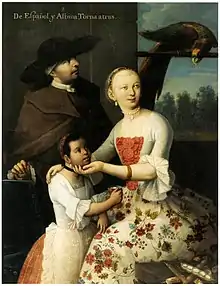Torna atrás
Torna atrás (Spanish pronunciation: [toɾnaˈtɾas]) or Tornatrás is a term once used in 18th century Casta Paintings to portray a mixed-race person (mestizo) who showed phenotypic characteristics of only one of the "original races",[1] that is, white, black, Amerindian, or Asian. The term was also used to describe an individual whose parentage was half white and half "albino".[1]
_LACMA_M.2011.20.2_(5_of_5).jpg.webp)
.jpg.webp)

Colonial Spanish America
The term torna atrás (in English, similar in meaning to "throwback" or "harken back to") could also refer to the appearance of racial characteristics not visible in the parents. An example is the child of a white person and a light-skinned person of African ancestry (albino)[a] born with darker skin than its African-descended parent.
The term torna atrás does not appear as a legal category in colonial documentation, but it is often shown in families portrayed in casta paintings in eighteenth-century Mexico.
| Miguel Cabrera, 1763[2] | Andrés de Islas, 1774[3] | Luis de Mena ca. 1750,[4] |
|
|
|
Philippines
It was also used in the Philippines during the Spanish colonial era from the 16th to 19th century, to describe persons of mixed Austronesian (referred to as Indio), Chinese (referred to as Sangley), and Spanish ancestry (referred to as Filipinos/Insulares or Peninsulares).
It is likely that some Filipino people today would have been classified as Tornatrás under this system due to centuries of intermarriage among various foreign and indigenous ethnic groups throughout the islands.
History
Although Tornatrás was originally used to describe a descendant of mestizos, albinos and Europeans, in the Philippines they were commonly known as those born from a Spanish father ('Filipino' or 'peninsular') and a mixed native and Chinese (mestiza de sangley) mother. Most people of the Tornatrás caste in the Philippines used Spanish as their primary language, and in many cases converted to the Catholic faith.
There are no official statistics on the number of people of Tornatrás ancestry around the world. Given historical and colonial patterns, it is believed that most are to be found in South America and the Philippines.
See also
References
- "Definición de tornatrás". Real Academia Española. Retrieved 21 September 2016.
- Katzew (2004), Casta Painting, 101-106. Paintings 1 and 3-8 private collections; 2 and 9-16 Museo de América, Madrid; 15 Elisabeth Waldo-Dentzel, Multicultural Music and Art Center (Northridge California).
- Katzew, Ilona. Program for Inventing Race: Casta Painting and Eighteenth-Century Mexico, April 4-August 8, 2004. LACMA
- Cline, Sarah. “Guadalupe and the Castas: The Power of a Singular Mexican Colonial Painting”. Mexican Studies/Estudios Mexicanos Vol. 31, Issue 2, Summer 2015, pages 218–247.
- Christopher Knight, "A Most Rare Couch Find: LACMA acquires a recently unrolled masterpiece." Los Angeles Times, April 1, 2015, A1.
Miscegenation in Spanish Philippines | |||||||||||||||||||||||||
|